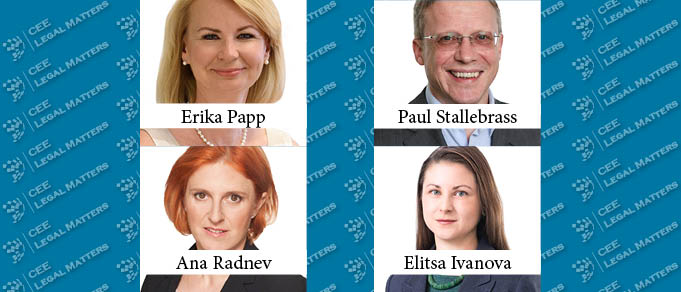As last year’s upheavals continue to influence finance markets in 2021, Erika Papp, CMS’s Head of Finance CEE/CIS, and CMS’s Regional Finance Partners Paul Stallebrass in Prague, Ana Radnev in Bucharest, and Elitsa Ivanova in Sofia offer their perspectives on what this year might hold for financing in CEE.
As last year’s upheavals continue to influence finance markets in 2021, Erika Papp, CMS’s Head of Finance CEE/CIS, and CMS’s Regional Finance Partners Paul Stallebrass in Prague, Ana Radnev in Bucharest, and Elitsa Ivanova in Sofia offer their perspectives on what this year might hold for financing in CEE.
CEELM: Last year was extraordinary in many ways. How has the pandemic shaped financial markets in Central and Eastern Europe so far – and what do you expect from 2021?
Erika: It’s been a remarkable story. At the start we were concerned there would be no new transactions. But all CEE countries enacted moratoria on loans and pumped cash into banks. Thus, the anticipated wave of bankruptcies did not materialize. Today we are much better placed to see how the CEE economies are coping. Poland, for instance, has weathered the storm better than most, while Hungary, by contrast, didn’t see as many new investments in 2020 as it had in previous years. Although much has depended on each country’s specific response to the pandemic, the CEE region as a whole has coped much better than we might have expected last spring.
This year promises many new deals in real estate and project financing, and the trends remain strong. Markets are busy in non-performing loans and banking M&A.
Paul: The most obvious impact of the pandemic was on the keenness to do transactions, especially in private equity, which suffered from the uncertainty. Some sectors did show resilience – for example e-retailers, who benefitted from the lockdowns, as well as the tech sector and pharma.
By the second quarter of this year, I expect the situation will be clearer and markets will pick up as a result of valuations stabilizing. It’s important to realize that right now people may be less inclined to sell due to poor numbers following a tough year.
CEELM: How are the current transactional trends in the region affecting acquisition finance and corporate lending in CEE?
Paul: There is plenty of liquidity in the market and substantial funds are available. On local markets, I expect a change in underwriting, with a shift away from syndication and more deals being done on a club basis, as they were after 2008. There is also potential for growth in IPOs instead of sales to PE or private buyers, and we have seen some successful examples of IPOs already over the last six months.”
CEELM: Has Brexit had any substantial impact on CEE finance transactions?
Paul: Brexit has not caused any significant problems among banks providing finance and has only had a minimal impact on the general financing market. The one consistent issue we’re seeing in CEE is questions regarding whether documentation should still be governed by English law. However, it’s misleading to think that Brexit is of any relevance here. English laws are arguably the best because of their flexibility and lack of statutory interference in commercial transactions – although that does not necessarily mean English courts are also best – and English remains the lingua franca of business in CEE. English law was used before CEE countries joined the EU and English laws govern contracts involving entities in jurisdictions outside the EU, like Singapore. In addition, English and EU courts will continue to recognize English law as the governing law of contracts, exactly as they did before Brexit.
Erika: As Paul notes, we’re getting a lot of inquiries about English law governing contracts in CEE. We still strongly recommend the use of English law. In addition, Brexit may cause a need for minor redrafting of specific clauses in certain deals, and of course there are alternative solutions if clients feel strongly about the governing-law issue. For example, parties completing a deal who are exclusively from one CEE country could agree to have that country’s laws govern. I do, however, always recommend that our clients keep using English law. For CEE, Brexit is no drama and actually offers new opportunities.
CEELM: Given the current climate, how do you think restructurings and NPLs will evolve in CEE this year?
Ana: Last year, governments helped businesses a great deal. Although each country took a different view, to a certain extent companies were able to postpone and defer payments. But that could not go on indefinitely, and today the plans that businesses have made are becoming more important. I expect we’ll see fewer restructurings this year. Things will be clearer by the second or third quarter of the year, after which I anticipate more disposals. However, I think these will be more medium-to-large, single-asset disposals.
Erika: One exciting development is the new EU Preventative Restructuring Directive, which is an entirely new way for struggling enterprises to stave off bankruptcy. This framework directive gives member states a great deal of latitude in implementing it and determining for themselves how their internal bodies will oversee restructurings. In addition, the framework offers vast flexibility, including allowing for the sale of the enterprise, and the swiftness it offers should really help troubled businesses.
CEELM: In your view, is CEE still an attractive destination for structured commodity and trade finance deals?
Elitsa: Yes certainly, and this will continue to be the case in 2021 as structured trade and commodity finance offers increasing opportunities. Ukraine is probably the most active market in CEE regarding structured commodity finance, especially for “soft” commodities: food and agriculture. There, we see investor confidence restored over recent years with tenors no longer restricted to one year or shorter, and some DCM activity particularly for large, vertically integrated argi-businesses. As Ukraine remains the grain house of Europe, the country offers a range of excellent opportunities. In the rest of CEE, companies are becoming more sophisticated, and while most of their financing is still based on straightforward bilateral revolving credit lines, we are starting to see larger and more complex structures as well, such as the occasional prepayment or borrowing base facility, as well as club and syndicated deals. The reason I do not mention Russia and CIS here is simply because I consider them in a category of their own, and not part of CEE; otherwise, there are also many opportunities there in terms of commodity finance work.
Risks in these types of investment do exist, of course. The pandemic caused a period of uncertainty and lessened demand from China for a period in 2020, especially in the metals and mining sectors. However, commodities resisted the pressure well, and the outlook for 2021 is positive.
CEELM: Are foreign banks particularly active in finance transactions in CEE?
Erika: Yes, foreign banks – especially Austrian and German banks – have traditionally been active in financing projects and transactions in our markets. Interestingly, we’re seeing more Asian banks arriving. To a degree this is a natural coda to the volume of investments coming from that part of the world. Chinese companies that enter CEE markets want to benefit from having their banks here to offer financing.
More importantly, we’re seeing new PE sponsors in the region. China’s GDP has enjoyed strong growth and PE investors are coming to this region to identify and partner with dynamic businesses.
CEELM: And what role do development banks in particular play in finance transactions in these markets?
Elitsa: International development banks have played an important role in providing resilience-based financing to businesses in CEE, supporting them through the pandemic. We saw a lot of that happening across a big part of our region and it was certainly encouraging to witness such a level of support across sectors.
Ana: Interestingly, the current situation itself is not stopping transactions from taking place – quite the opposite. Multi-lateral financing institutions such as EBRD are very active in the region. EBRD has already rolled out investments and disbursements to its clients and countries in CEE. It also acts as an anchor by encouraging others to get involved. Most importantly, the post-coronavirus recovery will be a sustainable recovery.
CEELM: Which areas or sectors do you see being on the rise with increasing opportunities, despite the pandemic?
Elitsa: Renewables are certainly on the rise across the region, including in terms of M&A activity and refinancing for existing projects. Regulation in that area is more stable as well, and as technology is much cheaper, projects can be financed from the market without the need for feed-in tariffs. Greenfield developments will almost certainly keep increasing because new capacities are required for governments to meet their green energy targets.
CEELM: On the subject of sustainable recovery and green energy targets, to what extent do sustainable investments resonate in CEE today?
Ana: It’s growing in importance all the time. We can see how investors insist on sustainability in investments. Typically, investors will include reporting obligations proving that green or other sustainability objectives are met by certain points in the lifetime of the investment. Large investors have their own in-house, specialized teams to ensure investments meet their sustainability targets. These targets can specify items in a broad range of issues, from environmental, social, governance responsibilities, to diversity in the workplace (such as promoting women).
Indeed, ESG issues have come under a new EU regulation called the Sustainable Finance Disclosure Regulation, which introduces several new concepts that businesses will need to understand when disclosing their ESG approach. At a high level, these include financial market participants, financial advisers, and financial products.
Each relevant entity needs to ask how it integrates sustainability risks into the investment decision-making process, how it takes into account the principal adverse impact of investment decisions on sustainability factors (on a comply or explain basis), and how its remuneration policies are consistent with the integration of sustainability risks.
It’s also important to remember that all products are captured – not only those related to ESG. All products will need to disclose the likely impact of sustainability risks on the returns of the product (or explain why such risks are not considered relevant). Product-level obligations for all financial products include the integration of sustainability risks, any principal adverse impacts, and marketing communications.
Finally, ESG-focused products that promote environmental or social factors, or which have a sustainability objective, are required to make additional disclosures, following the detailed frameworks set out in the Sustainable Finance Disclosure Regulation.
CEELM: Banks have been at the forefront of digitalization. What key developments and topics are keeping the financial markets busy in this space?
Erika: The digital transformation of the global economy is well underway, and the pandemic has only accelerated these changes. In a recent survey CMS conducted, 58% of businesses with CEE operations were already using AI solutions, while a significant majority – 83% – were planning AI-related investments. The banking sector is at the forefront of these developments, both globally and across CEE.
Digitalization is no longer the future but already the present, and several banks based in or present in CEE have been investing heavily in their digitalization projects for several years now. Digitalization brings a new way for banks established in CEE to regain market share and customers from fintech companies, which are now operating in more challenging market conditions. There are more than 600 fintech companies in the region, which presents an opportunity for banks to regain customers that had moved towards more digital-friendly alternatives.
A few examples include OTP Bank and its fintech company OTP Mobile; UniCredit, which recently completed significant digital projects; and Erste with its new digital platform. The future is promising for the banking sector in CEE.
CEELM: And finally, how much consolidation are you seeing on the banking market today?
Paul: Banking M&A is still moving forward despite the pandemic. For example, last year we saw some transactions in the Balkans. We are also likely to see an increase in transactions in the fintech sector and less-traditional banks, where CEE countries have tended to be quite successful. Of course, the coronavirus has caused some disruption, but the banking sector in CEE had enjoyed a fairly long period of stability before 2020. If the pandemic causes issues in their home countries for some of the international banks that are present to a limited extent in the region, they may seek to divest themselves of parts of their business that they view as non-core, which would in turn lead to an increase in banking M&A.
This Article was originally published in Issue 8.2 of the CEE Legal Matters Magazine. If you would like to receive a hard copy of the magazine, you can subscribe here.
















